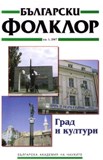Фолклорът като писмена култура – СбНУ в периода между двете световни войни
Folklore as Written Culture – the “Collection of Folk Creation” between the Two World Wars
Author(s): Tsveta Bachvarova–DumkovaSubject(s): Anthropology
Published by: Институт за етнология и фолклористика с Етнографски музей при БАН
Summary/Abstract: The problems of oral and written culture take an important place in the research trajectories of humanitarian cognition. The term “folklore”, created by W. J. Thoms in 1846 traces the penetration into different languages of Herder’s and Grimm’s ideas of the Volksgeist (the folk spirit). The visible border between the traditional, authentic, anonymous culture, existing in the space of orality and the literary culture in its written being is transformed in the concrete historical moment. The specifics of the written and the oral form are functionally signified in the context of everyday communication. If this communication should be projected on the screen of the socio-cultural system, especially in the nuance of tradition, then the respect towards the inherited grows in moments of change. The interest to and the collection of folklore facts in Bulgaria is closely connected to the “Collection of Folk Creation. Study and Literature”, founded in 1889. In his program article “The Significance and Task of Our Ethnography” Prof. Ivan Shishmanov potentially invents the couple “written/oral” as a part of the mapped out methodological program for documentation of folklore in the whole ethnic territory of Bulgaria. The attempts for cataloguing and systematization are closely connected to the concepts of inheritance and collective memory, which are especially productive in moments of historical perturbations. In the period between the two World Wars the ruined hopes of national unity re-discover the cumulative function and role of the Collection. It contains a significant volume of factual written data about different aspects of folklore culture. Its position is dubious – of an institution and of a creation. From the position of the scholarly distance two layers could be discerned in its content too. The first presents the recorded elements, the independent details in different collections; the seconds gives a generalized picture, presenting totalities, in which the facts are juxtaposed and interpreted. Thus the one view scrutinizes, while the other one stays at a distance in order to comprehend the whole picture. The two plans are united by the common idea for conservation of “antiquity” with the mediation of the written word, so that it should be included in the process of transmitting heritage, or otherwise it will be “lost”. The mechanisms of tradition and common memory move from the polyphony of human voices towards the “voiceless” letters. The written being makes folklore visible in detail, accessible. However, in this way it is deprived of its unity, partially reproduced, and turned into an object of observation. The “Collection of Folk Creation” emerges as a mediating textual space, where the criteria of the register are determined by scholarly cognition. The information charge, visible in the footnotes or in the small print “reported to…”, testifies for the interest to the theoretical interpretation of the phenomena from the “passing away” tradit
Journal: Български фолклор
- Issue Year: XXXIII/2007
- Issue No: 1
- Page Range: 80-85
- Page Count: 6
- Language: Bulgarian
- Content File-PDF

